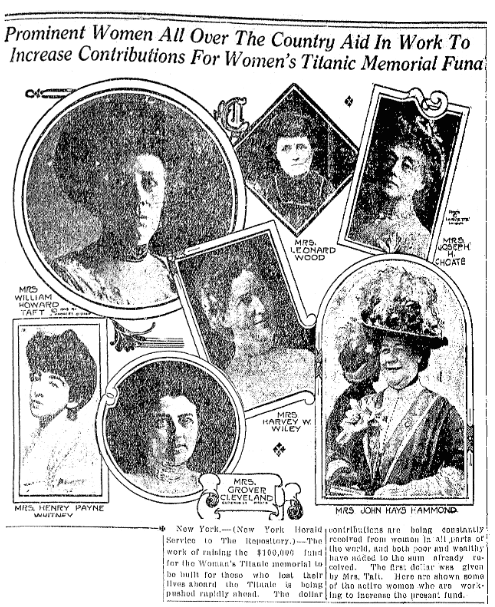Introduction: Gena Philibert-Ortega is a genealogist and author of the book “From the Family Kitchen.” In this blog article, Gena searches old newspapers to learn about the efforts of American women (who raised funds and commissioned a monument) to honor the courage of the men who sacrificed their lives during the sinking of the Titanic to protect women and children.
15 April 1912. You probably are well aware of what happened the previous night and in the early morning hours of that day. The unthinkable – really, the unsinkable – happened. The RMS Titanic hit an iceberg and the result was a catastrophic loss of life.
But what happened in the days and years that followed? Books have been written about that time period and much could be written about the stories of the survivors, the grief, and the investigations that followed.
As a result of the Titanic tragedy, a group of American women decided a memorial to the men of Titanic was in order. Those women came together to organize the Women’s Titanic Memorial Fund, later known as the Women’s Titanic Memorial Association.

The Women’s Titanic Memorial Fund
The Women’s Titanic Memorial Fund was different from other fundraising efforts. The funds were to be used to erect “…a monument, probably fan arch, at the capital, to the memory of the men who gave up their lives that the women of the lost ship might be saved.” This fundraiser, directed at women only, began weeks after the sinking. Men were asked not to contribute to this monument so that women alone could honor the Titanic example of “chivalrous manhood.” The women of America were asked to provide $1, which was deemed an affordable sum for nearly all to contribute (that would equal about $24 today).

First Lady Helen Herron Taft donated the first dollar and commented:
It gives me pleasure to start the Women’s Titanic Memorial Fund by giving the first dollar. I am glad to do this in gratitude to the chivalry of American manhood, and I am sure that every woman will feel that the smallness of the contribution solicited will enable her to do the same.
The Fund didn’t just rely on women sending in their dollar contribution; it also used events as a way to increase funds. In August, an outdoor dramatic performance at the Hammond villa was arranged by Mrs. John Hays Hammond, chairwoman of the Fund. The event added “several thousand dollars” to the cause.

By September 1912 the group had amassed $30,000 of the $100,000 needed for the monument.

November 1912 found the group continuing their fundraising efforts. This newspaper article includes photos of some of the prominent women who were working toward increasing contributions. These women include First Ladies Mrs. Grover Cleveland (Frances Folsom) and Mrs. William Taft (Helen Herron); as well as Mrs. Leonard Wood (Louise A. Condit Smith), wife of the military leader; Mrs. Joseph H. Choate (Caroline Dutcher Sterling), wife of the lawyer and the U.S. Ambassador to the United Kingdom; Mrs. Harvey W. Wiley (Anna Kelton), wife of the Chief Chemist at the U.S. Department of Agriculture; Mrs. John Hays Hammond (Natalie Harris), who was chairwoman of the Women’s Titanic Memorial Association and wife of the mining engineer and diplomat; and Mrs. Henry Payne Whitney (Gertrude Vanderbilt), artist and wife of the businessman.

The Memorial
Good works often take a long time to come to fruition and the Titanic Memorial was no exception. Years of fundraising paid off and a contest was held for the design of the memorial sculpture. Interestingly, the design chosen was by none other than one of the prominent women working toward the funding of the piece: Gertrude Vanderbilt Whitney, an artist in her own right. Her design was described in the newspaper:
The figure is suggestive of sacrifice, the upturned face symbolizes the resignation of the men to their fate, the pose of the body on tip toe expresses the final plunge into Eternity. The dimensions of the statue are 12 feet, 6 inches from tip to tip of fingers, and 12 feet height. The figure is decidedly that of a male.
In 1916 the sculpture was completed.

However, it wasn’t until 1925 that construction of a foundation (including a seawall) supporting the structure went out to bid. “The memorial is to be constructed under the authority of Congress, approved March 3, 1917, as a lasting tribute to the heroes who sacrificed their lives that women and children might be saved in the tragic catastrophe of the sinking of the steamship Titanic in May 1912 [sic].”
The Washington D.C. memorial was to be placed “in the Potomac River at the foot of New Hampshire avenue at the Intersection of 27th and E streets and the Rock Creek Drive going up Rock Creek Valley.”

The Unveiling of the Memorial
In 1931, 19 years after the sinking of the Titanic, the Memorial was unveiled. The statue ceremonies were presided over by President Herbert Hoover and his wife Lou Hoover, former First Lady Helen Taft, and other dignitaries. This newspaper article declares that over 20,000 women helped make the statue possible.
The base of the memorial bears two inscriptions. One reads: ‘To the Brave Men Who Perished in the Wreck of the Titanic April 15, 1912.They gave their lives that women and children might be saved.’ Beneath that inscription is the line: ‘Erected by the women of America.’
Another inscription reads: “Placed here by the women of America in honor of brave and unselfish manhood. This memorial is to the rich and the poor; ignorant and learned; old and young, who possessed in common God’s great gift of brave and unselfish manhood.”

The Memorial was moved in 1966 for the construction of the Kennedy Center. It now resides at Washington Channel Park where it is a reminder of the sacrifices that were made over 100 years ago – and the women who wanted to honor that sacrifice.
Titanic Blog Articles:
